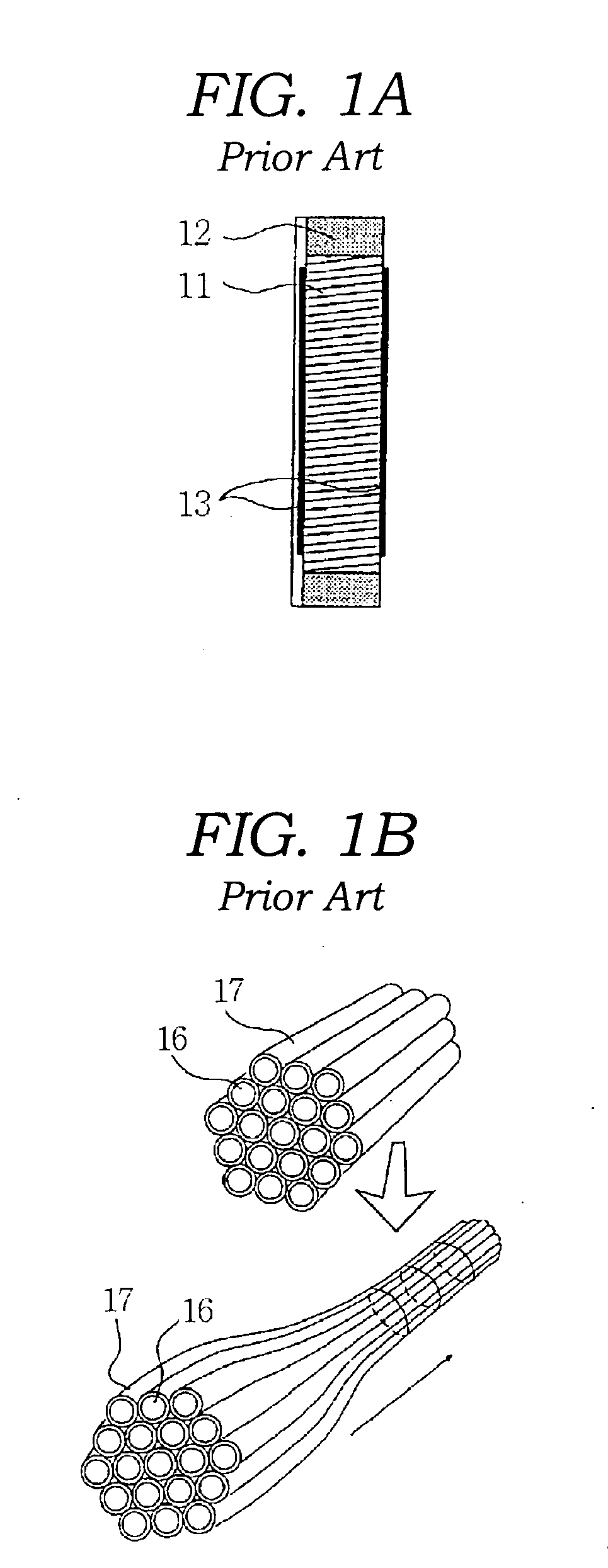Method and apparatus for producing microchannel plate using corrugated mold
a technology of corrugated molds and microchannel plates, which is applied in the manufacture of electrode systems, electric discharge tubes/lamps, electron multiplier details, etc., can solve the problems of high production costs, excessive temperature enhancement, and difficulty in large-area mcps production, and achieve cost reduction
- Summary
- Abstract
- Description
- Claims
- Application Information
AI Technical Summary
Benefits of technology
Problems solved by technology
Method used
Image
Examples
example 1
[0035] As shown in FIG. 4a, a first substrate 111 was placed on a corrugated mold, prepared by use of a plurality of first thin plates 101 and a plurality of second thin plates 102. As the first substrate 111, a polymer substrate formed of engineering plastics or a glass substrate was used. As shown in FIG. 4b, the first substrate 111 was heated by use of a heater 112 and a fan 113 until it was pliable enough to be vacuumed. While a vacuum was applied from a plurality of valleys 106 of the corrugated mold beneath the first substrate 111, assisted by an air passage in the mold, a high pressure air was applied over the first substrate 111. After a cooling process, a first corrugated substrate 111a having corrugated top and bottom surfaces resulted, to which a predetermined air pressure was applied through the air passage of the corrugated mold, to release the first corrugated substrate 111a from the corrugated mold.
[0036] Then, as shown in FIG. 4c, a secondary emitter was coated onto...
example 2
[0040] As shown in FIG. 5a, a substrate 111 was placed on a corrugated mold and a flat substrate 121 was placed on the substrate 111. As the substrate 111, a polymer substrate formed of engineering plastics or a glass substrate was used. As shown in FIG. 5b, the substrate 111 was heated by use of a heater 112 and a fan 113. Then, while a vacuum was applied from the valleys 106 of the corrugated mold beneath the substrate 111, assisted by the air passage in the mold, a pneumatic or hydraulic pressure was applied over the flat substrate 121. Thereby, the heated substrate 111 was drawn down into the valleys 106 of the corrugated mold. After a cooling process, a corrugated substrate 111b having a corrugated bottom surface resulted, to which a predetermined air pressure was applied through the air passage, to release the corrugated substrate 111b from the corrugated mold.
[0041] As shown in FIG. 5c, a secondary emitter was coated onto the corrugated substrate 111b, to prepare a secondary...
example 3
[0044] Instead of controlling electric resistance of the secondary emitter-coated layer 115 as in Example 1, an electroconductive layer 131 was positioned below the secondary emitter-coated layer 115, thereby feeding electrons to the secondary emitter-coated layer 115. Therefore, as shown in FIG. 6a, a first corrugated substrate 111a and a second flat substrate 114 prepared in the same manner as in Example 1 were coated with an electroconductive material to prepare the electroconductive layer 131. Then, a secondary emitter was coated on the electroconductive layer 131, thereby giving a secondary emitter-coated layer 115.
[0045] As such, as the electroconductive material, use was taken of conductive materials, such as metals or ITO (indium tin oxide). In addition, as the secondary emitter, SiO2, MgO, Al2O3, ZnO, CaO, SrO, LaO3, MgF2, CaF2, or LiF was used.
[0046] As shown in FIG. 6b, a plurality of the first corrugated substrates 111a and a plurality of the second flat substrates 114...
PUM
 Login to View More
Login to View More Abstract
Description
Claims
Application Information
 Login to View More
Login to View More - R&D
- Intellectual Property
- Life Sciences
- Materials
- Tech Scout
- Unparalleled Data Quality
- Higher Quality Content
- 60% Fewer Hallucinations
Browse by: Latest US Patents, China's latest patents, Technical Efficacy Thesaurus, Application Domain, Technology Topic, Popular Technical Reports.
© 2025 PatSnap. All rights reserved.Legal|Privacy policy|Modern Slavery Act Transparency Statement|Sitemap|About US| Contact US: help@patsnap.com



